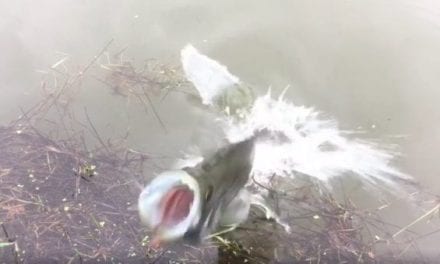 The Kansas Department of Wildlife, Parks and Tourism (KDWPT) has embarked on a three-year walleye study at Glen Elder Reservoir, and biologists want anglers to be aware of the project. Data collected during the study will give anglers and biologists a better understanding of what makes walleye tick in this lake. Throughout the study, KDWPT district fisheries biologist Scott Waters will follow the movements of adult walleye using telemetry to evaluate mortality patterns, movement, home range, and habitat selection.
The Kansas Department of Wildlife, Parks and Tourism (KDWPT) has embarked on a three-year walleye study at Glen Elder Reservoir, and biologists want anglers to be aware of the project. Data collected during the study will give anglers and biologists a better understanding of what makes walleye tick in this lake. Throughout the study, KDWPT district fisheries biologist Scott Waters will follow the movements of adult walleye using telemetry to evaluate mortality patterns, movement, home range, and habitat selection.
Ultrasonic transmitters were implanted in 27 walleye last fall and another 33 will receive transmitters in April. An equal number of males and females will be targeted, and not all study fish will be longer than the 18-inch minimum length limit.
The fish are collected using trap nets and gill nets and brought to shore. Each fish is placed in an anesthetic bath for several minutes before surgery. A 1.5-inch incision is made in the abdominal wall, and after the sex is determined, a 22-gram ultrasonic transmitter is placed in the abdominal cavity. Three sutures and glue are used to close the incision and an antibiotic is given to prevent infection. Once the fish regains equilibrium and resumes normal behavior, it is released.
Each fish is also tagged with a pink, 3-inch Floy tag in the dorsal fin to alert anglers who catch them. The tag contains the fish’s identification number, the KDWPT contact number, and a message about the $100 reward given for the return of the transmitter if the fish is kept. Not all tagged fish are of legal size, and short fish should be returned to the water with the tag intact. Anglers are encouraged to carefully measure the fish and report the length and location of catch to the park office. Anglers who harvest legal fish are encouraged to call or stop by the office to return the internal transmitter for the $100 reward. The angler may keep the fish and Floy tag.
Manual tracking will be conducted at least two times each month with more frequent tracking conducted during certain periods of the year. Once a fish is located, water depth and temperature, GPS location, and the identification number will be recorded. Angling mortality will be determined by tag returns, natural mortality will be determined when the transmitter shows no movement over time, and fish emigration will be detected using a stationary receiver. Daily movement patterns will also be studied by following a subsample of fish over a 24-hour period.
KDWPT biologists need anglers’ help with this study, which is unique for the state of Kansas and will provide answers about walleye life history that will help biologists better manage this important sport fish. Updates will be provided throughout the study to help anglers learn more about daily and seasonal walleye movement patterns and habitat preferences.
-30-
The post Glen Elder Reservoir (Kansas) Walleyes Carrying Telemetry Transmitters appeared first on OutDoors Unlimited Media and Magazine.
















